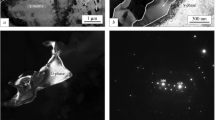Conclusions
The heat conductivity of the two-phase alloys of ZrC-W system increases with an increase of the tungsten content and with increase in temperature. This is caused by the electron contribution to the heat conductivity of the crbide phase.
The electrical resistance of these alloys decreases with increase in tungsten content and increases with increase in temperature. At a mass constant of ZrC > 25% the temperature dependence of the electrical resistance of the alloys is nonlinear as a result of slight overlapping of the valency band by the conduction band in the carbide phase.
The mean coefficient of thermal expansion ZrC-75% (wt.) W alloy increases with increase in temperature from 5.5·10−6 in the range 300–600 to 7.05·10−6 K−1 in the range 300–2300°K.
The spectral emission factor ɛλ=0.65 mm of the ZrC-W alloys increases with an increase of the zirconium carbide content. With increase in temperature\(\varepsilon _{\lambda _e } \) decreases for tungsten, zirconium alloy, and alloys with a mass content of W < 40%. For the alloys with a tungsten content of 45–75%\(\varepsilon _{\lambda _e } \) depends only slightly on temperature. This can be explained by the presence of tungsten carbides in the subsurface layer. The critical wavelength of these carbides (λX=500–600 nm) is close to the wavelength in pyrometric measurements.
The fracture tensile stress of the specimens of the alloys with a mass constant of tungsten of 75% increases with increase in temperature as a result of utilization of a certain ductility margin of the brittle material.
Similar content being viewed by others
Literature cited
P. A. Komozynskii, N. G. Kalinina, V. S. Neshpor, et al., “Concentration dependence of ZrC-W alloys,” Zh. Tekh. Fiz.,46, No. 3, 552–557 (1976).
B. G. Livshits, Physical Properties of Metals and Alloys [in Russian], Mashgiz, Moscow (1959).
A. T. Tumanov and K. I. Portnoi (ed.), Refractory Materials in Engineering, [in Russian], Mashinostroenie, Moscow (1967).
E. Storms, Refractory Carbides [in Russian], Atomizdat, Moscow (1970).
D. G. Zaiman, Electrons and Photons [Russian translation], Il, Moscow (1962).
L. S. Wendel and W. Williams, “High temperature thermal conductivity of transition metal crbides and nitrides,” J. Am. Ceram. Soc,49, 156–159 (1966).
G. V. Samsonov, G. T. Upadkhaya, and V. S. Neshpor, Physical Material Science of Carbides [in Russian], Naukova Dumka, Kiev (1974).
V. S. Neshpor, V. I. Novikov, and V. P. Nikitin, “Superconductivity and residual resistance of titanium carbide,” Izv. Akad. Nauk SSSR, Neorg. Mater.,7, No. 10, 1743–1747 (1971).
Yu. P. Paderno, T. V. Andreeva, I. G. Barantseva, and Yu. M. Goryachev, “Nature of the heat conductivity of carbides of certain transition metals of the groups IV and V,” Poroshk. Metall., No. 2, 60–64 (1967).
B. A. Fridlender and V. S. Neshpor. “Thermal expansion of crbides of transition metals of groups IV–VI,” Teplofiz. Vys. Temp.,14, No. 5, 553–556 (1976).
E. K. Ostrovskii, V. S. Neshpor, P. A. Komozynskii, et al., “Examination of thermal electron emission and structural transformations in alloys of carbides of transition metals of group IVa with W and Mo during long-term tests,” Zh. Tekh. Fiz.,49, No. 3, 611–617 (1971).
V. Éspe, Technology of Electrovacuum Materials [in Russian], Vol. 1, Gosenergoizdat, Moscow (1962).
N. M. Karnaukhova, V. A. Luknitskii, and I. A. Maslov, “Measuring the evaporation rate by the langmuir method of a number of ZrC-x%W compositions at temperature range 2300–3000°K in mass spectrometric inspection of residual vacuum,” Zh. Tekh. Fiz.,46, No. 8, 1758–1764 (1974).
A. Ya. Tontegode, “Special features of diffusion of interstitial atoms through the metal-gas interface boundary,” Zh. Tekh. Fiz.,33, No. 5, 1042–1058 (1975).
T. Ritghof, B. D. Engon, and E. R. Branyn, Basic Concepts and Current Methods of Temperature Measurements [in Russian], Metallurgiya, Moscow (1967).
A. S. Vander, I. A. Vrytov, and V. S. Neshpor, “Chemical composition and Fermi Electron Spectrorefractory compounds of zirconium with a variable composition,” in: 10th All-Union Symposium on electron Structure and Physicochemical Properties of Refractory Compounds and Alloys, L'vov University, L'vov (1983), p. 9.
E. K. Ostrovskii, L. G. Bednyak, V. S. Neshpor, et al., The Stability of Emission Properties of ZrC-W alloys, Deposited at the Elektroniks Central Scientific Institute, No. 5627/78, 1978.
M. G. Loshak, Strength and Endurance of Hard Alloys [in Russian], Naukova Dumka, Kiev (1984).
Author information
Authors and Affiliations
Additional information
Translated from Poroshkovaya Metallurgiya, No. 6(330), pp. 93–100, June, 1990.
Rights and permissions
About this article
Cite this article
Neshpor, V.S., Fridlender, B.A., Komozynskii, P.A. et al. Examination of the physical properties of ZrC-W carbide-metallic alloys. Powder Metall Met Ceram 29, 502–508 (1990). https://doi.org/10.1007/BF00795353
Received:
Issue Date:
DOI: https://doi.org/10.1007/BF00795353



